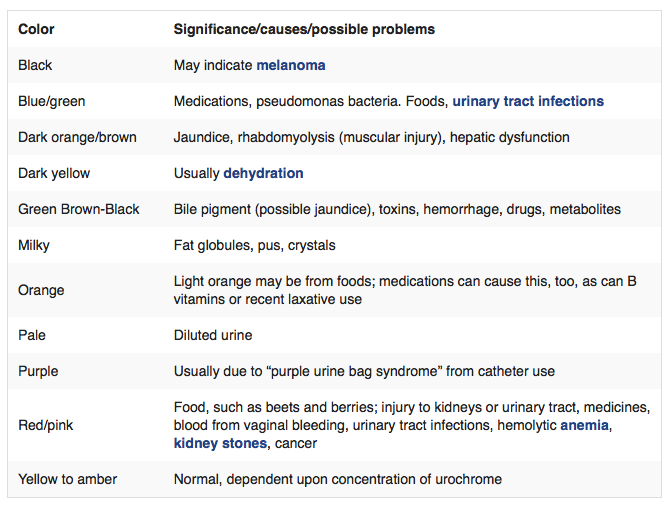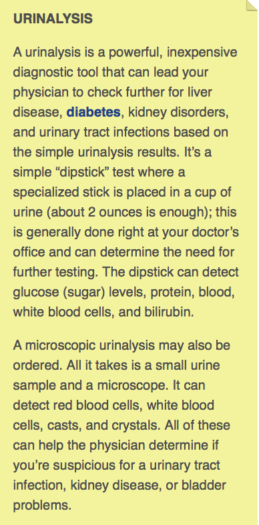 Your urine color reflects what you eat and drink, and even the medications you take. But it’s a red alert for any shade of red, black, or brown, especially when accompanied by other symptoms.
Your urine color reflects what you eat and drink, and even the medications you take. But it’s a red alert for any shade of red, black, or brown, especially when accompanied by other symptoms.
Pretty much everyone knows his or her normal urine color (or subtle range of urine colors). If the shade changes a great deal, however, we can become a little alarmed.
But hold on. While urine color is a centuries-old diagnostic tool, many shades of yellow can be perfectly normal, even if they vary from nearly colorless to dark yellow.
Urine color reflects what we consume, and water can significantly change your urine color. In fact, some experts advise, if your urine color is nearly that of water, you may be overdoing the “hydrate” bit. Conversely, if your urine color is a deep, dark yellow, you may need to step up your water intake.
Food, Vitamins, and Urine
Food and vitamin supplements can make a difference in urine color as well. Berries, beets, and foods that contain high amounts of food coloring can all have an effect. Have you seen fluorescent-green urine come out of your body? B vitamins such as riboflavin (B2) and cobalamin (B12) may be at play. Yellow and orange foods can result in dark yellow or even orange urine. Asparagus can even have your urine color shading brown.
Even medicines can cause your urine color to become temporarily abnormal. Ironically, a phenazopyridine hydrochloride (Pyridium) is sometimes used to treat urinary tract infection symptoms, and it may cause the urine to be orange. It’s important to note that phenazopyridine does not treat the infection itself, but it does help ease urinary pain.
That said, if your urine color is anything but yellowish—and you can’t determine why (medications, food, water consumption)—you should consider a trip to the doctor.
Urine Color Meanings
The normal yellow urine color comes from a pigment called urobilin or urochrome. The yellow is the result of dead liver cells being expelled from your body.
When your doctor looks at a urine sample, the urine color will be analyzed and reported with the urinalysis.
 A bloody urine color means high-tail it to your doctor. It could indicate one of the following:
A bloody urine color means high-tail it to your doctor. It could indicate one of the following:
* A urinary tract infection
* Kidney problems or tumors
* Bladder issues or tumors
* An enlarged prostate
Urine in your blood is called “hematuria.”
 If your urine color is bloody brown and you’ve been exercising heavily, you should consult your doctor at least the first time. “We do not know why strenuous exercise can cause blood leaking in the urinary tract, but it could have to do with fluid balance (dehydration), blood cell breakdown, or bladder trauma,” says RunnersWorld.com.
If your urine color is bloody brown and you’ve been exercising heavily, you should consult your doctor at least the first time. “We do not know why strenuous exercise can cause blood leaking in the urinary tract, but it could have to do with fluid balance (dehydration), blood cell breakdown, or bladder trauma,” says RunnersWorld.com.
Frothy urine can indicate a high level of protein in the blood, which the American Kidney Fund says may indicate worsening kidney damage, especially if you’re also experiencing swelling in your hands or feet.
“Cloudy or milky urine is a sign of a urinary tract infection, which may also cause a bad smell, says the U.S. National Library of Medicine. “Milky urine may also be caused by bacteria, crystals, fat, white or red blood cells, or mucus in the urine.”
Doctor’s Office
Your physician will take abnormal urine color seriously. Always see your physician immediately if you think you may have blood in your urine or if your urine color is dark brown or worse. Other urine color decisions may be based on your personal history but should not be ignored. If the abnormal urine color persists, see your doctor.
At the physician’s office, you will be asked for your medical history, a history of the problem, what times you notice the odd urine color, and if you noted any other symptoms (fever, pain, nausea, thirst). Be prepared to tell him or her your diet and all medications and supplements you are taking.
Blood tests, including liver function tests, may be ordered. Depending upon the findings, your doctor may require an ultrasound or cystoscopy, which allows the doctor to examine your bladder and urinary tract.
Written by Cindy Foley and published by Universal Health News Daily ~ August 14, 2018.
 FAIR USE NOTICE: This site contains copyrighted material the use of which has not always been specifically authorized by the copyright owner. We are making such material available in our efforts to advance understanding of environmental, political, human rights, economic, democracy, scientific, and social justice issues, etc. We believe this constitutes a ‘fair use’ of any such copyrighted material as provided for in section 107 of the US Copyright Law. In accordance with Title 17 U. S. C. Section 107, the material on this site is distributed without profit to those who have expressed a prior interest in receiving the included information for research and educational purposes. For more information go to: http://www.law.cornell.edu/uscode/17/107.shtml“
FAIR USE NOTICE: This site contains copyrighted material the use of which has not always been specifically authorized by the copyright owner. We are making such material available in our efforts to advance understanding of environmental, political, human rights, economic, democracy, scientific, and social justice issues, etc. We believe this constitutes a ‘fair use’ of any such copyrighted material as provided for in section 107 of the US Copyright Law. In accordance with Title 17 U. S. C. Section 107, the material on this site is distributed without profit to those who have expressed a prior interest in receiving the included information for research and educational purposes. For more information go to: http://www.law.cornell.edu/uscode/17/107.shtml“
